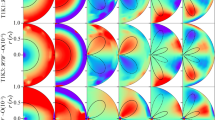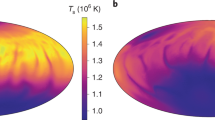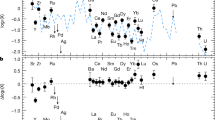Abstract
PULSARS are generally thought to be rapidly rotating neutron stars which have poloidal magnetic fields with intensities consistently in the range 1012–1013 gauss (ref. 1). Most of them are believed to evolve from main sequence stars with original masses of >1.4–∼8 M⊙. Evolutionary computations2,3 indicate that stars in this mass range develop a dense core of carbon and oxygen in which carbon begins to burn when the temperature reaches about 3 × 108 K and the density about 3 × 109 g cm−3. The rapid production of energy during this carbon-burning stage drives almost the entire core into convection for an extended time of the order of 1011 s (ref. 4), with convective velocities of the order of 104 cm s−1 (ref. 5), provided that the rate of cooling through the convectively driven ‘Urca process’ is sufficiently high to stabilise carbon burning and to prevent the core from detonating and dispersing. If this sequence is a reasonable approximation to reality then the existence of neutron star pulsars suggests that carbon burning is, in fact, stabilised until electron capture, or some other process, causes part of the core to collapse to a neutron star2–7.
This is a preview of subscription content, access via your institution
Access options
Subscribe to this journal
Receive 51 print issues and online access
$199.00 per year
only $3.90 per issue
Buy this article
- Purchase on Springer Link
- Instant access to full article PDF
Prices may be subject to local taxes which are calculated during checkout
Similar content being viewed by others
References
Ruderman, M., A. Rev. Astron. Astrophys., 10, 427 (1972).
Rose, W. K., Astrophys. J., 155, 491 (1969).
Paczynski, B., Acta. astr., 21, 271 (1970).
Couch, R. G., and Arnett, W. D., Astrophys. J. Lett., 180, L101 (1973).
Paczynski, B., Astrophys. Lett., 11, 53 (1972).
Arnett, W. D., Astrophys. space Sci., 5, 180 (1969).
Bruenn, S. W., Astrophys. J. Lett., 183, L125 (1973).
Ruderman, M. A., and Sutherland, P. G., Nature phys. Sci., 246, 93 (1973).
Parker, E. N., Astrophys. J., 122, 293 (1955); and 162, 665 (1970).
Braginskii, S. I., Soviet Phys. JETP, 20, 726, 1462 (1964).
Steenbeck, M., Krause, F., and Rädler, K.-H., Z. N. Naturf., 21 a, 369 (1966).
Parker, E. N., Astrophys. J., 163, 255 (1971).
Levy, E. H., Astrophys. J., 171, 621 (1972).
Radler, K.-H., Z. Naturf., 23 a, 1851 (1968).
Parker, E. N., Astrophys. J., 163, 279 (1971).
Levy, E. H., and Rose, W. K., Astrophys. J. (in the press).
Author information
Authors and Affiliations
Rights and permissions
About this article
Cite this article
LEVY, E., ROSE, W. Origin of neutron star magnetic fields. Nature 250, 40–41 (1974). https://doi.org/10.1038/250040a0
Received:
Published:
Issue Date:
DOI: https://doi.org/10.1038/250040a0
This article is cited by
-
Sustained magnetic fields in binary millisecond pulsars
Nature (1987)
-
On the origin and structure of stellar magnetic fields
Astrophysics and Space Science (1983)
-
Pulsar slow-down epochs
Nature (1981)
-
How do neutron stars evolve?
Naturwissenschaften (1977)
Comments
By submitting a comment you agree to abide by our Terms and Community Guidelines. If you find something abusive or that does not comply with our terms or guidelines please flag it as inappropriate.



